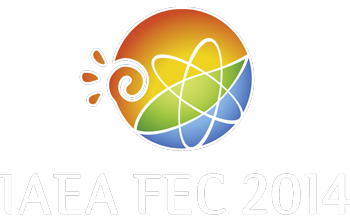Speaker
Ms
Inessa Bolshakova
(Lviv Polytechnic National University)
Description
Radiation resistant sensors and magnetic measuring instrumentation have been designed and its performance in the conditions of fusion reactors have been demonstrated, by the international research collaboration between researchers from different countries supported by STCU (Science and Technology Center in Ukraine) projects and funded from the EU, USA, Japan and Canada.
Created radiation-resistant semiconductor sensors of magnetic field have received an experimental evaluation during their testing in nuclear research reactors, and showed their performance under the conditions of neutron fluences several times higher than the maximum neutron fluence in steady-state sensor locations in ITER reactor (>10х18 n/cm^2).
3D probes with Hall sensors have been successfully tested in European reactors TORE SUPRA and JET. Notably, long-term operation of sensor and equipment has been demonstrated over the period of 5 years (2009-2014) at JET.
Works targeting further increase in radiation resistance and measurement accuracy of magnetic measuring equipment with Hall sensors are currently underway, namely:
• New radiation modification methods of semiconductor sensors have been developed for their parameter stabilization in ITER-like neutron fluxes.
• Materials for sensors with new properties and high sensitivity to magnetic field have been created on the basis of nano-size InAs/i-GaAs heterostructures.
• High precision 3D magnetometers have been created to measure the spatial distribution of magnetic induction vector.
Conducted studies have confirmed the long-term operation of the developed magnetic measuring sensors in ITER-relevant conditions and promising qualities of these development products for DEMO.
| Country or International Organisation | Ukraine |
|---|---|
| Paper Number | FIP/P4-7 |
Author
Ms
Inessa Bolshakova
(Lviv Polytechnic National University)
Co-authors
Mr
Alexandr Vinnichenko
(National Research Nuclear University “Moscow Engineering Physics Institute”, Russia)
Mr
Andrea Murari
(EURATOM/CCFE Fusion Association, Culham Science Centre, Abingdon, UK)
Mr
Antonio Quercia
(EURATOM/CCFE Fusion Association, Culham Science Centre, Abingdon, UK)
Mr
Fedir Shurygin
(Magnetic Sensor Laboratory, Lviv Polytechnic National University, Lviv, Ukraine)
Mr
Ivan Duran
(Institute of Plasma Physics AS CR, Prague, Czech Republic)
Mr
Ivan Vasilevskiy
(National Research Nuclear University “Moscow Engineering Physics Institute”, Russia)
Mr
Mihail Strikhanov
(National Research Nuclear University “Moscow Engineering Physics Institute”, Russia)
Mr
Nikolay Kargin
(National Research Nuclear University “Moscow Engineering Physics Institute”, Russia)
Mrs
Olena Makido
(Magnetic Sensor Laboratory, Lviv Polytechnic National University, Lviv, Ukraine)
Mrs
Raisa Konopleva
(B. P. Konstantinov Petersburg Nuclear Physics Institute, Saint Petersburg, Russia)
Mr
Sergey Belyaev
(B. P. Konstantinov Petersburg Nuclear Physics Institute, Saint Petersburg, Russia)
Mr
Sergey Gerasimov
(EURATOM/CCFE Fusion Association, Culham Science Centre, Abingdon, UK)
Mr
Sergey Timoshyn
(Magnetic Sensor Laboratory, Lviv Polytechnic National University, Lviv, Ukraine)
Mr
Valeriy Chekanov
(B. P. Konstantinov Petersburg Nuclear Physics Institute, Saint Petersburg, Russia)
Mr
Vincenzo Coccorese
(EURATOM/CCFE Fusion Association, Culham Science Centre, Abingdon, UK)
Mr
Yaroslav Kost
(Magnetic Sensor Laboratory, Lviv Polytechnic National University, Lviv, Ukraine)

